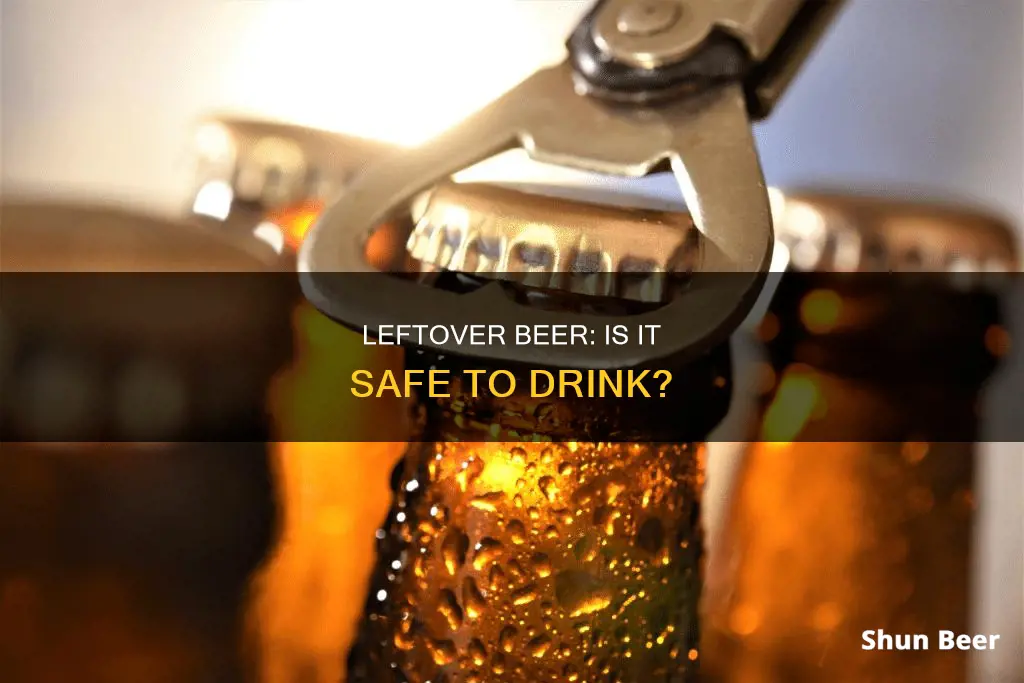
Beer is a beloved beverage for many, but what happens when it's left outside? Can you drink it? Well, it depends. A few factors determine a beer's shelf life, including whether it's open or closed, and the storage conditions. Generally, unopened beer can last up to six months if stored at room temperature, but its flavour will be optimal for about four to six months. On the other hand, an open beer bottle is only fresh for one to two days, and its taste will deteriorate quickly if left outside.
Leaving beer outside, even if it's unopened, can affect its quality. Exposure to warm temperatures, sunlight, and oxygen can all impact the flavour and freshness of your brew. Warm temperatures can diminish hop flavours and aromas, while malt flavours can turn into an unpleasant, generic sweet taste. Sunlight can also cause flavour deterioration, which is why beer bottles are often darkly tinted. Additionally, oxygen exposure can cause oxidation, impacting the colour and flavour of the beer.
If you're wondering about that beer you left outside, it's important to consider the storage conditions and the duration it was left out. If it was unopened and stored in a cool, shaded area for a short period, it might still be drinkable but may have lost some of its optimal flavour and freshness. However, if it was open or left outside for an extended period, it's best to discard it as it could be contaminated or spoiled. Always check for signs of spoilage, such as an unpleasant odour, strange taste, or cloudiness, before consuming. Remember, while drinking stale beer may not make you ill, it can certainly ruin your taste buds and leave you with an unpleasant drinking experience.
What You'll Learn

How long can I leave closed beer outside?
A sealed beer can stay at optimal quality for about 4 to 6 months when stored at room temperature. However, the moment you open a beer bottle, its freshness reduces to a mere 1-2 days. After this timeframe, the beverage will likely lose its carbonation, flavour, and freshness.
You can still drink a beer that has been left out overnight without exposing yourself to health risks, but it will likely be flat without its initial flavour. Refrigerating an open beer after leaving it out can slow oxidation and preserve its freshness for a little longer. However, the overall quality and taste of the beer may still be affected as exposure to oxygen will continue even in cold temperatures.
If you buy beer in bulk, it is recommended to take various measures to extend its shelf life. Store it in cool, dry areas or refrigerators and limit its exposure to sunlight. At the same time, keep your beer bottles and cans tightly sealed to ensure it remains fresh for longer.
Exploring Fort Myers Beach: Beer and Beyond
You may want to see also

What are the signs of spoilage in beer?
Beer spoilage can be identified through a few key indicators. Firstly, an unpleasant odour is a tell-tale sign of spoilage. This could range from a skunky, urine-like smell to a rotten egg odour, which is caused by the production of hydrogen sulfide. Beer spoilage organisms, such as Lactobacillus brevis and Pediococcus damnosus, are often responsible for these undesirable odours.
Secondly, strange tastes are another clear indication of spoilage. Common off-flavours include a buttery taste, resulting from the production of diacetyl, and sour or metallic flavours, which arise from bacterial contamination or oxygen exposure. Cloudiness or haziness in the beer is also an indicator, although some craft beers may naturally have a hazy appearance.
Finally, visible mould growth on the beer is a sure sign of spoilage and indicates improper packaging or storage. It is important to note that spoilage may not always be apparent, and proper storage conditions, such as cool temperatures and protection from light, are crucial to maintaining the quality of the beer.
To summarise, the key signs of spoilage in beer are unpleasant odours, strange tastes, cloudiness, and visible mould growth. When in doubt, it is always better to err on the side of caution and discard the beer rather than risk consuming a spoiled beverage.
The Magic of Beer Thieves: How Do They Work?
You may want to see also

How does temperature affect beer?
Temperature plays a critical role in determining a beer's shelf life. Beer stored in a warm place above room temperature will quickly lose its freshness. Conversely, storing beer in a refrigerator prolongs its freshness.
Ideally, beer should be stored at typical refrigerator temperatures of 35°F to 46°F. If you don't have access to a refrigerator, choose a cool, dark, and undisturbed place such as a pantry or cellar. These areas have lower temperatures, which will help your beer last longer.
The sun's rays are particularly detrimental to beer, as they trigger a chemical reaction that breaks down its taste components, causing flavour deterioration. This process is more prominent in beers like India Pale Ales and other light beers, which are best consumed within three months of packaging.
While it is a common misconception that warming a cold beer will ruin it, this is simply not true. In fact, letting a cold beer come to room temperature has no effect on its flavour. However, extreme heat (above 80°F) will ruin your beer.
Additionally, higher-than-normal temperatures can negatively impact a beer's flavour over an extended period. Heat accelerates the oxidation process, causing some beers to develop a stale, cardboard-like flavour with a hint of sherry. Malt-forward beers may even take on a sweet, bready, or toffee-like taste. The "hoppiness" of a beer will also dissipate under extreme heat, and any piney, citrusy, or floral hop aromas will be lost.
Therefore, it is essential to store beer in a cool, dry place, away from direct sunlight and heat sources, to maintain its quality and taste.
Beer and Zyrtec: A Safe Mix?
You may want to see also

How does sunlight affect beer?
Sunlight can have a detrimental effect on beer, causing it to spoil and become unpleasant to drink. The sun's rays are known to shorten the shelf life of beer, penetrating the bottles and triggering a chemical reaction that breaks down its taste components, causing flavour deterioration.
This process is particularly prominent in beers like India Pale Ales and other light beers, which are best consumed within three months of packaging. However, it can also affect craft varieties such as IPAs, Pale Ales, Kolsch, and Amber if they are not stored properly in dark places.
The light wavelengths that cause beer to spoil fall between about 350 and 550 nanometers; 350 nm is in the ultraviolet range (invisible to the human eye), and 550 nm is in the visible range. These wavelengths are associated with purple, blue, and green colours. Sunlight is the main culprit behind this effect, but fluorescent lighting can also cause it, which is often found in stores and beverage display cases.
Clear bottles offer little protection against sunlight, as light passes through this transparent glass easily. Green-coloured bottles offer some protection but still allow light to pass through. Brown bottles are the most effective at blocking light and providing the most protection for beer.
To prevent beer from spoiling due to sunlight exposure, it is recommended to store it in a cool, dark place, such as a pantry or cellar, or in a refrigerator. Additionally, beer should be stored upright and sealed properly to minimise oxygen exposure, which can also cause the beverage to spoil.
By following these storage recommendations, you can help prolong the shelf life of beer and maintain its optimal quality and flavour.
Beer Subscriptions: How Do They Work?
You may want to see also

How can I extend the shelf life of beer?
Beer can be safely consumed past its expiration date, but it may not taste very good. To extend the shelf life of beer, it is important to store it properly.
Storage Temperature
Beer should be stored in a cool, dry place. The ideal temperature range is between 45 and 55 degrees Fahrenheit (7-13 degrees Celsius). Beer stored within this temperature range can last for up to six months. Beer stored in a refrigerator can last for up to two or three years.
Light Exposure
Beer should be stored in a dark place, away from direct sunlight and other sources of light. Exposure to UV rays can cause the beer to spoil and develop a "skunky" odour and taste. Dark bottles offer better protection from light than clear or light-coloured bottles.
Oxygen Exposure
Oxygen exposure can cause oxidation, which degrades the beer's flavour and colour. Canned beer offers better protection from oxygen exposure than bottled beer. Storing beer upright can also help to reduce the surface area of the beer that is in contact with oxygen.
Container
Kegs, bottles, and cans are common containers for beer. Canned beer typically has a longer shelf life than bottled beer due to its sealed and lightless nature. Bottled beer stored in dark bottles that block out UV rays will last longer than those stored in clear or light-coloured bottles.
Type of Beer
Not all beers have the same shelf life. Hoppy beers, lagers, and ales typically have a shorter shelf life, while darker or aged beers such as stouts, porters, barley wines, and Belgian ales can last longer.
Other Tips
- Avoid temperature fluctuations, as rapid changes in temperature can negatively impact the beer's quality and taste.
- Do not freeze and thaw beer, as this can affect its carbonation levels and taste.
- Keep the beer sealed when not in use.
- Consume the beer within 3 to 6 months of the expiration date for optimal taste and quality.
Beer and Heart Murmurs: What You Need to Know
You may want to see also
Frequently asked questions
Drinking closed beer that has been exposed to outdoor temperatures is not recommended. While it may not make you sick, the quality and taste of the beer will be significantly compromised due to oxidation and exposure to UV light.
The shelf life of unopened beer depends on various factors, including storage conditions. Beer should be stored in a cool, dry, and dark place. Leaving closed beer outside for an extended period can accelerate spoilage, and it is best to avoid doing so.
Beer left outside may still be drinkable, but its flavour and freshness will be affected. The beer may taste stale, flat, or develop unpleasant flavours, and it will likely be less enjoyable.
Check for signs of spoilage, such as an unusual smell or taste. If the beer has been exposed to extreme temperatures or sunlight, it may have deteriorated and should be discarded.
To prolong the shelf life of closed beer, it is essential to minimise temperature fluctuations and protect it from direct sunlight. Store the beer in a cool, shaded area, and ensure it is consumed promptly to maintain optimal quality.







